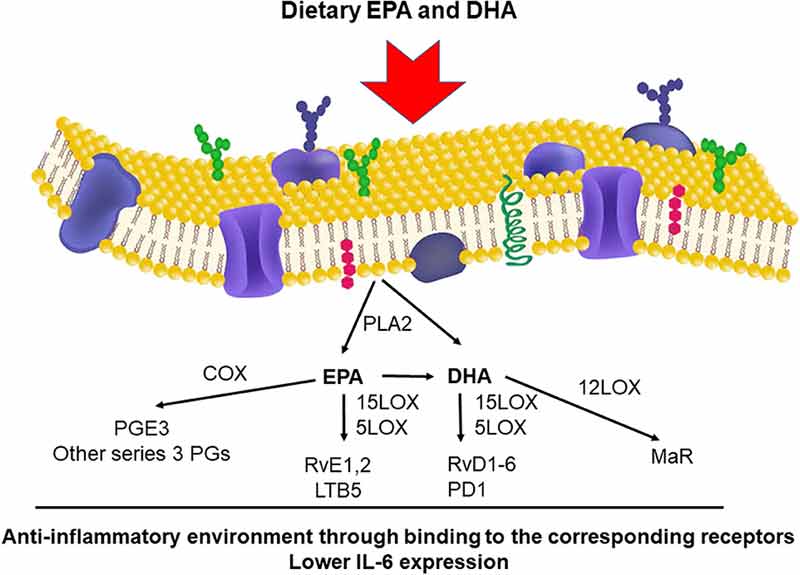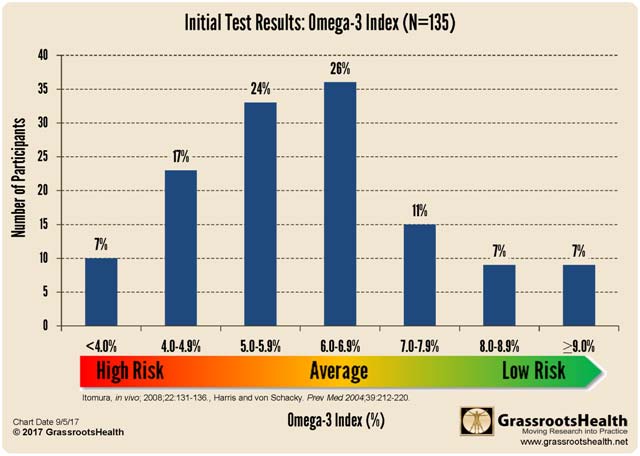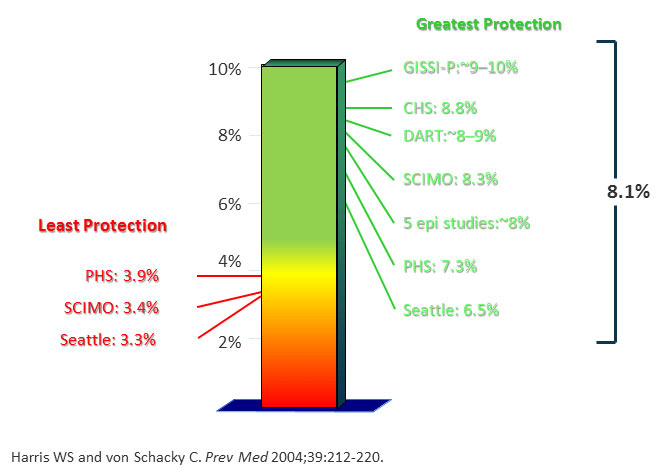Éviter le risque de tempête de cytokines avec les Oméga-3
De : https://articles.mercola.com/sites/articles/archive/2022/11/22/omega-3-fats-epa-and-dha.aspx?
Les articles anglais gratuits de Dr Mercola deviennent payants après 48H. Sauf ici, entre autres. La traduction automatique est possible ici : https://translate.google.com/website?sl=hl&en=fr&hl=fr&u=https://etouffoir.blogspot.com/2022/11/eviter-le-risque-de-tempete-de.html
How Omega-3 Might Help Prevent Cytokine Storm
Story at-a-glance
- Evidence suggests the omega-3 fats EPA and DHA affect biological pathways that may have direct influence in the outcome of COVID-19
- EPA and DHA have a direct influence in the immunological response to viral infections and can modulate immune response and function
- Animal-based omega-3 fats, especially DHA, also help prevent thrombosis (a blood clot within a blood vessel) by decreasing platelet aggregation. Hypercoagulation is another complication of severe COVID-19 infection that can have lethal consequences
- Omega-3 also lowers your risk of lung dysfunction, protects against lung damage and secondary bacterial infections, and improves mitochondrial function
- Research shows that by lowering triglycerides, the risk of developing a cytokine storm is diminished. Omega-3 supplementation is known to lower triglycerides, but krill oil does so more effectively than fish oil
By now, you're probably aware that one of the lethal effects of COVID-19 is the virus' ability to trigger a cytokine storm. It makes sense then that many health practitioners are looking at ways to strengthen and improve immune function. The good news is there are several strategies that appear very helpful in this respect.
Supplements and strategies that have been identified as capable of modulating immune responses and suppressing cytokine storm include but are not limited to:
- Vitamin D optimization
- Molecular hydrogen
- Ketone esters
- Astaxanthin
- Melatonin
To this list, we can also add the omega-3 fats docosahexaenoic acid (DHA) and eicosapentaenoic acid (EPA), long-chained omega-3 fats found in cold-water fatty fish like wild-caught Alaskan salmon, sardines, anchovies and krill, just to name a few.
DHA and EPA May Ameliorate Cytokine Storm
According to the opinion paper "The Potential Beneficial Effect of EPA and DHA Supplementation Managing Cytokine Storm in Coronavirus Disease," published June 19, 2020, in the journal Frontiers in Physiology, EPA and DHA are known to affect biological pathways that "may have direct influence in the outcome of COVID-19:"1
"To date, the molecular events that precipitate a 'cytokine storm' or the applicable therapeutic strategies to prevent and manage this process is not elucidated because of the complex nature of this problem.
Recent articles suggest that specific nutrients such as vitamin B6, B12, C, D, E, and folate; trace elements, including zinc, iron, selenium, magnesium, and copper may play a key role in the management of cytokine storm …
LC-PUFAs (long chain polyunsaturated fatty acids) such as EPA … and DHA … are noteworthy because of their direct influence in the immunological response to viral infections. Evidence suggests that n-3 LC-PUFAs can modulate the immune response and function in many ways.
Among these complex immunomodulatory effects, interleukin-6 (IL-6) and interleukin-1ß (IL-1β) — because of the suspected central regulatory role in the 'cytokine storm' — should be highlighted. These cytokines can be affected by dietary EPA and DHA intake (Figure 1).
In addition, poly(ADP-ribose) polymerase enzymes that have anti-inflammatory properties, translatable to human COVID-19 infection were shown to improve tissue levels of DHA and EPA, as well as the downstream anti-inflammatory metabolites of EPA and DHA further underscoring the applicability of DHA and EPA in COVID-19."
Figure 1: Main pathways for the metabolism of DHA and EPA yielding anti-inflammatory metabolites.

While not mentioned in this Frontiers in Physiology paper, animal-based omega-3 fats, especially DHA, have also been shown to prevent thrombosis (a blood clot within a blood vessel) by decreasing platelet aggregation. As discussed in "COVID-19 Critical Care," hypercoagulation is another complication of severe COVID-19 infection that can have lethal consequences. Omega-3 also:
- Lowers your risk of lung dysfunction
- Protects against lung damage
- Protects against secondary bacterial infections
- Improves mitochondrial function
Marine- Versus Plant-Based Omega-3
Unfortunately, the authors recommend using "algae- or plant-based sources of EPA and DHA" rather than marine-based sources. I believe this is a mistake. While microalgae2 do contain DHA and EPA and are a viable source for strict vegetarians, as previously discussed in "The Critical Differences Between Omega-3 Fats From Plants and Marine Animals," most plant-based omega-3s actually do not contain any of the long-chain omega-3 fats, DHA and EPA.
As mentioned, ideal sources of DHA and EPA are marine-based and include cold-water fatty fish like wild-caught Alaskan salmon, sardines and anchovies. If you do not eat these fish on a regular basis, consider taking a krill oil supplement. To learn more about why krill oil is preferable over fish oil, see the infographic below.

As it pertains to the issue of cytokine storm, the authors of the Frontiers in Physiology paper3 point out there are at least three studies showing that by lowering triglycerides, the risk of developing a cytokine storm is diminished, and krill oil, specifically, has been shown to lower triglycerides more effectively than fish oil.4
Do You Know Your Omega-3 Index?
Along with vitamin D testing, measuring your omega-3 level at least once a year is strongly recommended, as being low in this vital nutrient can spell trouble for your health in more ways than one.
One of the reasons why DHA and EPA are so crucial is because they're actually key structural elements of your cells; they're not just simple fuel. If you don't have enough DHA and EPA, your body's ability to repair and maintain healthy cell structures is seriously impaired.
The assay to measure omega-3 in your red blood cells was developed by William Harris, Ph.D., in 2004. The omega-3 index is expressed as a percent of all fatty acids in the red blood cell membrane.5 Data from studies Harris performed showed an ideal, healthy range of omega-3 is 8% to 12%.6,7
GrassrootsHealth co-founder Carole Baggerly commented on the Frontiers in Physiology paper in a personal email to me: "Based on this data, it is highly likely that the higher omega-3 would help prevent the cytokine storm … I would … get up to the index level of 8.1% at least."
Not only do you want to make sure you are getting sufficient omega-3, but it is also absolutely imperative you limit your omega-6 intake, especially from processed vegetable oils. I discuss this in greater detail in a section below. This is another benefit of the omega-3 index test, as it will show you precisely the levels of these potentially dangerous fats in your cells.
How to Test Your Omega-3 Level
GrassrootsHealth, a nonprofit public health research organization, has several cost-effective testing options available as part of its consumer-sponsored nutrient research projects,8 the aims of which are to establish population-based nutrition recommendations based on science-backed data.
For example, ongoing research by GrassrootsHealth has established the ideal vitamin D range for disease prevention is between 60 and 80 ng/mL. It conducts the same kind of consumer-sponsored research for omega-3 and magnesium. For omega-3, you have four test options:
- Omega-3 index test kit
- Vitamin D and Omega-3 test kit
- Vitamin D, Magnesium and Omega 3 test kit
- Vitamin D, Magnesium and Omega 3 PLUS Elements test kit — This kit includes measurements of essential minerals (magnesium, selenium, zinc and copper) as well as harmful heavy metals (cadmium, lead and mercury)
Each kit contains instructions for how to collect your blood sample. You then mail in your sample and fill out a quick online health questionnaire through GrassrootsHealth. Your test results will be emailed to you in about 10 to 20 days after your samples are received.
Based on your index result, you will then be able to use GrassrootsHealth's omega-3 index calculator9 to determine the dosage you may require to raise your current level to your chosen target level.
Don't Assume Your Omega-3 Intake Is Adequate
Avoid the temptation to assume that your omega-3 index is sufficient just because you're eating fish or taking a supplement. Many fish do not contain high omega-3 levels (you have to eat cold-water fatty fish to reap that benefit), and many fish oil supplements are synthetic with questionable efficacy.
As reported by GrassrootsHealth,10 of the first 135 participants in the D*action + Omega-3 home testing project, 85% had an omega-3 index below 8%, which is the lower threshold for sufficiency, putting them at increased risk for heart disease11 and other chronic diseases, as well as death from any cause.

As reported by GrassrootsHealth:12
"In studies using a measurement called the Omega-3 Index test, individuals with a low Omega-3 Index were shown to have a 10-fold higher risk of death compared to those with a high index … An Omega-3 Index between 8% and 12% was associated with lower risk for death from cardiovascular disease, versus an index less than 4%."

Important: Limit Your Vegetable Oil Intake
Again, while many need a marine-based omega-3 supplement to get their level up, it's also crucial to limit your intake of omega-6 fats from vegetable oils. This even includes some healthy oils such as virgin olive oil.
Aside from the fact that a majority of olive oils are fake, even the real McCoy can cause trouble when consumed in too-high amounts, as it's loaded with omega-6 and therefore can skew your omega-3 to omega-6 ratio.
Ideally, this ratio should be close to 1-to-1, but because people eat so little omega-3 and excessive amounts of omega-6, it's not uncommon for this ratio to be closer to 1-to-25 of greater. When your consumption is this skewed, you may still have a hard time optimizing your omega-3 index, even when taking a supplement.
It's important to realize that your body metabolizes omega-3 and omega-6 polyunsaturated fatty acids (PUFAs) into eicosanoids, which are hormone-like substances. As a general rule, omega-3 eicosanoids are anti-inflammatory while omega-6 eicosanoids have proinflammatory effects.13
Part of the benefits of omega-3 fats is that they block the proinflammatory effects of omega-6 eicosanoids, but if your omega-6 intake is too great, you may still have high rates of inflammation. Omega-6 fats also:14
- Create reactive species that damage DNA
- Cause 17-beta-estradiol epoxidation, which in turn generates a carcinogenic compound
- Enhance the genotoxic effects of other compounds
Many Consume Enormous Amounts of Vegetable Oils
According to the 2017 U.S. Department of Agriculture report,15 "U.S. Trends in Food Availability," consumption of healthy saturated animal fats such as butter, lard and beef tallow fell by 27% between 1970 and 2014, while consumption of harmful vegetable oils rose by 87%. Intake of salad and cooking oils specifically rose by 248%.
As noted in "New Study Tells Why Chicken Is Killing You and Saturated Fat Is Your Friend," which features a podcast interview with Dr. Paul Saladino and Nina Teicholz, conventional chicken is also a hidden source of harmful omega-6 linoleic acid, due to the fact that they're fed corn. So, your best bet is to eat the eggs, not the chicken.
Compelling evidence suggests processed vegetable oils, rich in omega-6 polyunsaturated fatty acids, are likely the primary culprit in our modern diet, contributing to the development of just about all chronic diseases. I believe they take a greater toll on human health than high fructose corn syrup even.
Not only have vegetable oils been linked to heart disease, gastrointestinal diseases such as irritable bowel disorder and inflammatory conditions such as arthritis, they've also been linked to cancer, especially neuroblastoma, breast, prostate, colon and lung cancer.16
In a November 8, 2019, Medium article,17 Maria Cross, a nutritionist with a master of science degree, discusses the science behind vegetable oils and what makes them carcinogenic. She explains:
"There are two classes of PUFA: omega-6 and omega-3. Although functionally distinct and non-interchangeable, these two classes are perpetually engaged in a metabolic balancing act, pushing and pulling as they compete for absorption in the body.
There is nothing intrinsically wrong with omega-6 PUFAs: we need them … That's why scientists believe that it is not omega-6 per se that is to blame; it's the balance between the two groups of PUFA that is out of kilter and wreaking havoc on our bodies.
We evolved on, and are genetically adapted to, a diet that provides more or less equal amounts of omega-3 and omega-618 … Experimental data19 supports the theory that it is this skewed balance between the two PUFAs that influences the development of a tumor."
Similarly, the 2002 paper20 "The Importance of the Ratio of Omega-6/Omega-3 Essential Fatty Acids" points out that:
"Excessive amounts of omega-6 polyunsaturated fatty acids (PUFA) and a very high omega-6/omega-3 ratio, as is found in today's Western diets, promote the pathogenesis of many diseases, including cardiovascular disease, cancer, and inflammatory and autoimmune diseases, whereas increased levels of omega-3 PUFA (a low omega-6/omega-3 ratio) exert suppressive effects."
Vegetable Oils Are Toxic in Their Own Right
In addition to promoting chronic disease by throwing your omega-3 to omega-6 ratio off kilter, vegetable oils also have more direct toxic effects. One of the reasons for this is because they degrade when heated, forming extremely toxic oxidation products such as cyclic aldehydes.21
Cyclic aldehydes cause oxidized low-density lipoprotein (LDL) associated with heart disease. They also crosslink tau protein and create neurofibrillary tangles, thereby contributing to the development of neurodegenerative diseases.
As explained by Dr. Cate Shanahan in her book, "Deep Nutrition: Why Your Genes Need Traditional Food,"22 in order to understand how dietary fats affect your health you need to understand how fats oxidize.
The omega-6 PUFAs found in vegetable oils have highly perishable bonds that react with oxygen, creating a free radical cascade that turns normal fatty acids in your body into dangerous high-energy molecules that wreak havoc in a way similar to that of radiation.
What's more, many of the vegetable oils produced today — especially corn and soy oil — are genetically engineered and a significant source of glyphosate exposure, and glyphosate has also been linked to gut damage and other health problems.
Omega-6 Oils Are Integrated Into Your Cells
Shanahan's book also expounds on the hazards of 4-hydroxynonenal (4HNE), which is the oxidized form of omega-6 vegetable oil and forms during the processing. 4HNE is highly toxic, especially to your gut bacteria, and consumption of 4HNE has been correlated with having an obesogenic balance of gut flora.
4HNE causes cytotoxicity and DNA damage, and instigates free radical cascades that damage the mitochondrial membrane. The omega-6 found in vegetable oils also damages the endothelium (the cells lining your blood vessels), allowing LDL and very low-density lipoprotein (VLDL) particles to penetrate into the subendothelium.
Importantly, these oils get integrated into your cell and mitochondrial membranes (just like healthy omega-3s), and once these membranes are impaired, it sets the stage for all sorts of health problems.
They also make cell membranes less fluid, which impacts hormone transporters in the cell membrane and slows your metabolic rate, and inhibit the removal of senescent cells — aged, damaged or crippled cells that have lost the ability to reproduce and produce inflammatory cytokines that rapidly accelerate disease and aging.
Vegetable oils also strip your liver of glutathione (which produces antioxidant enzymes), thereby lowering your antioxidant defenses,23 and inhibit delta-6 desaturase (delta-6), an enzyme involved in the conversion of short-chained omega-3s to longer chained omega-3s in your liver.24
Important Steps You Can Take to Improve Your Omega-3 Index
Remember, omega-6 and omega-3 oils are polyunsaturated oils and highly susceptible to oxidation and becoming biologically damaged. This is why it is NOT as simple as merely adding omega-3 oils to your diet to improve your ratio. Merely increasing your omega-3 could actually make your health worse by increasing the oxidized fats.
The absolute key is to be assiduous in removing ALL vegetable oils. You simply should avoid them at all costs. Another source high in omega-6 oils is chicken meat. Chicken is very high in the omega-6 fat linoleic acid because they eat so many omega-6 rich grains.
One of the best ways you can get a handle on how many omega-6 oils you are eating is by using the incredible nutrient tracking app call Cronometer. If you use the app on your desktop, it is completely free. As long as you are accurately weighing your foods when you enter them, it will give you a fantastic estimate of how many omega-6 oils you are really eating.
This may be one of the most important and least expensive health strategies you can implement today.
Additionally, as noted in my recent interview with Dr. Chris Knobbe, omega-6-rich oils have a half-life of 600 to 680 days in your body. That means it can take quite a few years to empty your body stores of these damaging omega-6 fats. That said, eliminating them from your diet now will, over time, allow your body to rid itself of them, thus steadily improving your health.
Optimizing Your Omega-3 May Be Helpful COVID-19 Prevention
In summary, as with vitamin D, optimizing your omega-3 index to a level of at least 8% may be a strategy that can help lower your risk of an adverse COVID-19 outcome, as omega-3 fats are important modulators of immune function25 and can help lower your risk of a cytokine storm.
Just remember that increasing your intake of omega-3 may not be sufficient. In all likelihood, you also need to limit your intake of vegetable oils, including corn-fed chickens. Together, these two strategies should allow you to achieve a healthy omega-3 to omega-6 ratio.
- 1, 3 Frontiers in Physiology, June 19, 2020 DOI: 10.3389/fphys.2020.00752
- 2 Current Diabetes Reviews 2007 Aug;3(3):198-203
- 4 University Health News May 4, 2020
- 5 The American Journal of Clinical Nutrition, 2008;87(6)
- 6 OmegaQuant, July 9, 2018
- 7, 12 GrassrootsHealth, Omega-3 Call to Action
- 8 GrassrootsHealth Research Projects
- 9 Omega-3 index calculator
- 10 GrassrootsHealth, How to Maintain Healthy Omega-3 Levels
- 11 GrassrootsHealth, What Are Optimal Levels of Omega-3? Why?
- 13 International Journal of Biological Chemistry 2016; 10(1-4): 1-6, Ratio Matters
- 14 Boletin Medico Del Hospital Infantil de Mexico November-December 2016; 73(6): 445-456, Table 2
- 15 U.S. Department of Agriculture, U.S. Trends in Food Availability 1970-2014 (PDF), Page 24
- 16 Boletin Medico Del Hospital Infantil de Mexico November-December 2016; 73(6): 445-456, Abstract
- 17 Medium November 8, 2019
- 18 International Journal of Biological Chemistry 2016; 10(1-4): 1-6, Abstract
- 19, 20 Biomedicine & Pharmacotherapy 2002; 56: 365-379 (PDF)
- 21 Science Daily February 22, 2012
- 22, 23, 24 Deep Nutrition: Why Your Genes Need Traditional Food by Dr. Cate Shanahan
- 25 Omega-3 Fatty Acids September 16, 2016: 307-320


Commentaires
Enregistrer un commentaire